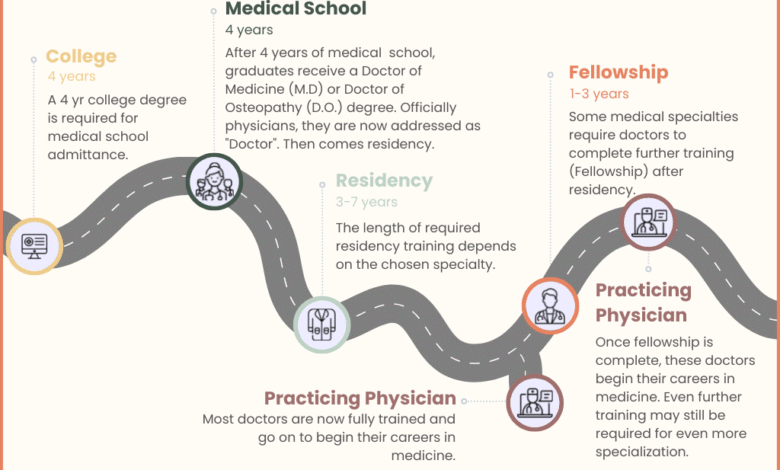How Long Does It Take to Become a Doctor? A Simple Guide for Curious Minds

Have you ever asked yourself, how long does it take to become a doctor? Many people think it’s just a few years, but the truth is, it takes time, effort, and a big heart. If you dream of wearing that white coat and helping others feel better, you’re not alone! This journey is long but full of exciting learning steps. In this blog, we’ll explain it like we’re telling a friend, so it’s easy to understand. Whether you’re in school or just thinking ahead, knowing how long it takes to become a doctor can help you plan better. We’ll break it all down — from high school all the way to wearing a stethoscope for real. No tricky words, no boring stuff — just clear answers.
So, how long does it take to become a doctor in real life? First, you go to high school like everyone else. After that, you usually need four years of college. That’s where you learn science, like how the body works. Then comes medical school — another four years! But you’re still not done. After medical school, you enter something called “residency,” which is like learning on the job. This can take three to seven more years. That means it can take about 11 to 15 years total! Some doctors do even more learning if they want to become super specialists, like heart doctors or brain doctors. But don’t worry — you don’t have to know everything now. We’ll walk you through it step by step in the rest of this blog.
What Does the Journey to Become a Doctor Really Look Like?
Becoming a doctor takes many years, but each step teaches something important. First, you go to high school and do your best in science and math. Then, you go to college for about four years to study subjects like biology or chemistry. After college, you enter medical school, which is another four years. That’s where you learn about the body, medicine, and how to treat people. But that’s not the end! After medical school, you must do residency. This is where you train in real hospitals and clinics, and it lasts between three to seven years. So, in total, the journey to become a doctor can take 11 to 15 years. It’s long, but every year helps you become better. If you love helping people, this path is worth it. Many doctors say it’s hard, but also the best thing they ever did.
How Long Does It Take to Become a Doctor After High School?
After high school, it usually takes around 11 to 15 years to become a doctor. First, you need to finish four years of college. That helps you get ready for medical school. Then, you study for four more years in medical school. That’s where you learn about the body and medicine. After that, you need to work in real hospitals during something called “residency.” This can take three to seven more years, depending on what kind of doctor you want to be. Some people take longer if they want to study even more and become a very special kind of doctor. It’s a big journey, but you don’t have to rush. Take one step at a time. Each part of the journey helps you learn new things. So, if you start after high school, you’ll need time, hard work, and heart to reach your dream.
College Comes First: Why 4 Years Matter Before Medical School
Before you can go to medical school, you must go to college. This usually takes four years. In college, you learn the basic things that will help you understand medicine later. Most students pick subjects like biology, chemistry, or health science. But even if you choose something different, you still need to take special science classes called “prerequisites.” These are things like biology, chemistry, physics, and math. You also learn how to study, how to write clearly, and how to manage your time. These skills help you a lot when you go to medical school. Many students also join clubs, do research, or help in hospitals while in college. That makes their medical school application stronger. So those four years are super important. They get you ready for the next step. You can’t skip college if you want to be a doctor — it’s the first big block in your path.
What Happens in Medical School? Let’s Break Down the 4 Years
Medical school is where your doctor training really starts. It takes four years and is split into two main parts. The first two years are classroom time. You study how the body works, what happens when people get sick, and how medicine helps. You learn things like anatomy, pharmacology, and pathology. It’s a lot of reading and studying! Then, in the third and fourth years, you move into hospitals and clinics. This is called clinical training. You see real patients, talk to them, and learn how doctors make decisions. You’re not working alone — real doctors guide and teach you. You also get to try different kinds of doctor work, like pediatrics, surgery, or family medicine. This helps you choose what kind of doctor you want to be. Medical school is hard, but exciting, because you start doing real doctor things for the first time.
Clinical Rotations: How You Learn by Doing
In the last two years of medical school, students do something called clinical rotations. This is when you stop sitting in classrooms and start learning in hospitals. You follow real doctors and nurses and watch how they treat patients. You also talk to patients, take notes, and even help with small tasks. Each rotation is in a different part of medicine. For example, one month you might learn about kids in pediatrics, and the next you learn about surgery. This helps you understand many types of doctor jobs. You also find out which type of doctor you might want to be. It’s like trying different shoes until one fits perfectly. Clinical rotations are super important because they show you how doctors work every day. You learn by doing, not just reading. It’s one of the best ways to get ready for your future job.
How Long Does Residency Last After Medical School?
After medical school, doctors must do residency. Residency is like your first real job as a doctor, but you’re still learning. It usually lasts between 3 to 7 years. The time depends on the kind of doctor you want to be. If you want to be a family doctor, residency is about 3 years. If you want to be a brain doctor or heart surgeon, it might be 6 or 7 years. During residency, you work in hospitals full-time. You treat patients, make decisions, and learn from senior doctors. You also take more tests to become fully licensed. Residency is hard work and has long hours, but it’s the final step before becoming a full doctor. It’s when all your training comes together. Many doctors say they learn the most during these years. So yes, it’s tough — but it’s also the most exciting part of the journey.
How Long Does It Take to Become a Doctor in Different Specialties?
Not all doctors do the same job, and not all take the same time to train. Some doctors want to be general doctors like family medicine, and that takes about 11 years total. But others want to be experts in one area, like heart doctors or brain surgeons. These specialties need more years of training. For example, if you want to be a pediatrician (a kids’ doctor), you might do three years of residency. But if you want to be a neurosurgeon (a brain doctor), you might train for seven years or more after medical school. Some doctors even do something called a “fellowship” after residency to learn something even more special. That can take extra years too. So, how long does it take to become a doctor? It depends on what kind of doctor you want to be — some paths are shorter, and some are much longer.
Conclusion
Becoming a doctor takes time, but it’s a step-by-step journey. First, you go to college, then medical school, and then do your residency. Each step teaches you something new. It may feel like a lot, but you don’t have to do it all at once. Just keep going one step at a time.
If you dream of helping people, being a doctor can be a great job. Yes, it takes many years, but many doctors say it’s the best thing they ever did. You learn, grow, and help others feel better. That makes all the hard work worth it in the end.
FAQs
Q: How long does it take to become a doctor after high school?
A: It usually takes 11 to 15 years, including college, medical school, and residency.
Q: Can I skip college and go straight to medical school?
A: No, you must complete college first before you can apply to medical school.
Q: What is residency?
A: Residency is hands-on doctor training in hospitals that happens after medical school.
Q: Do all doctors take the same number of years to train?
A: No, some specialties take longer than others, like surgery or brain doctors.
Q: Is becoming a doctor worth it?
A: Yes! It’s hard work, but many people find it very rewarding and exciting.



